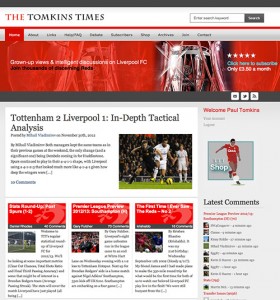By Si Steers.
There used to be a very well defined football media in England. The established mainstream media had a vice-like grip over opinion and the news agenda. Clubs had little direct access to supporters, so were beholden to journalists who had an influential voice.
But the landscape has shifted, and it is continuing to evolve. The news agenda is now moving faster than ever before, to the point that news ‘papers’ are almost redundant as a source of news. In the digital age where news is instant, the conversation has generally shifted by the time a newspaper goes to print.
The established media are struggling to keep up with a changing landscape. The line between journalist and blogger is becoming blurred. As people look to a broader media for opinion on subject specific topics, it is more difficult for journalists to retain the same level of insight.
The changing face of the media presents opportunities and risks to football clubs. It allows more direct conversation and influence over supporters, but it also means that supporters can be and will want to be heard.
Football clubs have to shift the communications focus; whilst the traditional role of media relations remains an important function, the sheer scale of digital media presents a real challenge in managing communications.
Let’s take Liverpool FC as a case study…
If you asked 50 Liverpool fans where they went for Liverpool news and opinion, you will probably get 20 different answers. Whilst the mainstream media may still score highly for news (or rumours), how many supporters use fan sites or media to help inform opinion?
There are a huge amount of Liverpool fan sites, and a much smaller number of very influential ones; if you look at followers on Twitter for This is Anfield (130k), TTT (60k), The Anfield Wrap (35k) for example, all three of those sites have a voice that can help to influence opinion on a large scale.
On an individual basis, Paul Tomkins has a similar amount of followers to Tony Evans, the football editor for the Times. Paul is an expert writer on one football club, and his Twitter followers include a vast majority of mainstream football journalists. It is similar to Gareth Roberts and Jim Boardman, two more respected Liverpool commentators. Even football journalists are turning to the club-specific writers, bloggers and experts to form opinion.
The growing influence of ‘fan sites’
Liverpool FC has almost 1.8m Twitter followers and 12.2m likes on Facebook. Those numbers have become a bit of a stick to beat the club with in some ways, as they look to adapt to a digital age. But they do give an indicative guide to the scale of the club’s global support.
Within the fan base there are a range of disparate views on how the club is progressing, and there is a wide range of media that will help push an idea or opinion. The explosion of fan sites is feeding a thirst for information. Twitter and Internet Forums provide opportunity for discussion on Liverpool every single day.
Whereas in bygone years you could pick up the Mirror with a cup of coffee to get the latest news and maybe read an opinion piece on your club, with a chat with your mates after a game or down the pub, football now consumes your life as a supporter. It is constant; anybody with a smart phone can access Twitter, Facebook, the Internet, listen to podcasts – wherever you go, you can feed your thirst for knowledge.
It makes it very difficult for the mainstream media to keep up. If you gave Liverpool supporters the choice of listening to a TAW v a Times article or a TTT v a Guardian podcast on Liverpool, I’d be surprised if either the Times or Guardian came out on top. It is quite interesting that a lot of football journalists may make an appearance on a ‘fan site’ podcast, or be willing to do an interview. They know that they are becoming the channels that influence opinion.
The premium fan sites (such as TTT) are in my mind the blueprint for how football media especially will evolve. People do not mind subscribing to quality content, and that is true of either the Times or TTT. I think we will see much more entrepreneurial journalism in football as the digital age continues to evolve, to the point where we may even see well known football journalists cross the divide!
Communications challenges
The changing face of media in football does present some very difficult challenges to communications teams. With so much noise, controlling your message and reputation becomes a real challenge.
It is perhaps harder for football clubs than most organisations to control what is said about them. There is a huge number of Liverpool bloggers (as well as the independent sites, there is also the official Liverpool FC hub ‘the Kop’ which has blogging facilities’).
But one thing I have been impressed about at Liverpool is that they are adapting much faster than most clubs to the digital age. They seem to have recognised that the mainstream media are no longer the biggest influence on supporters.
By treating the fan sites as media outlets, the club is ensuring it keeps an element of control over its messaging. It is important that fan sites don’t lose the air of independence, as the majority of them have built credibility by pushing an objective and balanced agenda.
It is in the club’s interests to utilise fan sites, bloggers and subject specialists to help push its message. There will be occasions where using a fan site (a classic example was John Henry’s email to the Anfield Wrap on the Stadium) will give a message more credibility. A fan site can be an independent channel with a credible voice; sometimes fans see the official site as being too ‘corporate’ (which it has to be) and the mainstream media as lacking credibility.
Liverpool FC seems to have a very good grasp of digital media, especially social media. There is a very difficult balance with content,as there isn’t an easy ‘tone’ that can engage local and global supporters (perhaps a thankless task!). But in purely commercial terms, the growth of the club’s digital media has been impressive. Translating that into revenue is the next part of that process.
New media channels
Another seismic shift on the media landscape is the access to new channels for bloggers. Whereas radio and television used to be only accessible to those in the mainstream media, podcasts and You Tube open up a whole new world.
The huge success of the Anfield Wrap podcast is an example of how a ‘fan site’ can quickly develop real influence. With over 30k listens a week, that is a really loud voice. The Bib Theorists podcast which are only 18 episodes in has almost 100k listens in total. Podcasts are becoming an alternative channel for fan sites to talk about the club.
It can only be a matter of time before a fan site perhaps does a live webcast. This is a channel that mainstream journalists use to share opinion and build up credibility.
The club uses film extensively as part of its premium content package. It also has its own in-house television channel; meaning that it can broadcast directly to supporters without a reliance on the mainstream media.
New media channels will continue to evolve and complement Twitter and fan sites as alternative channels to the mainstream media.
In my opinion, Twitter is the single biggest game changer the media has ever seen. It has its good and bad moments, but it has opened up a gateway to instant news and opinion that has changed the face of journalism forever.
Whereas journalists used to be able to hide behind opinion, Twitter now provides a platform for challenging a point of view (within reason!!). The Luis Suarez incident with Patrice Evra was a real case study in the power of Twitter. Whilst most mainstream journalists immediately took the moral high ground, many were forced to defend a position that clearly had two strong arguments.
Whilst it may not have influenced coverage, in my experience many journalists at least appreciated the point of view in Suarez’s defence. Twitter gives you the opportunity to challenge populist opinion and offer an alternate point of view.
Twitter is also incredibly fast paced, the news agenda changes in an instant. Twitter is also a useful tool for journalists and bloggers; it is a channel to push out opinion to a large audience.
Like any social media tool, Twitter has its flaws. But there can be little argument that it has completely changed the face of the global media.
So what does the future of football media look like? I personally think that there is still a role for the mainstream media, but they will need to react to a much more competitive environment. Whilst they may not retain the influence they once did, they do still have a relevant voice at a very holistic level. I think we will see much more of journalists working with fan sites of specific clubs to build up profile and credibility.
I think for Liverpool, the shift in communications approach is clear. Whilst the club will still want to retain good relationships with journalists; there is also recognition that fan sites are gaining more influence and credibility as established media outlets.
On a personal level, my number one site for Liverpool news, opinion and analysis is the Tomkins Times, and whilst I have my own ideas about the club, it is TTT that has helped shape my opinion more than any other media outlet!
Where do you go for your Liverpool opinion (not news)?
- The Tomkins Times (41%, 683 Votes)
- The Anfield Wrap (13%, 217 Votes)
- Individual Twitter Accounts (11%, 176 Votes)
- Liverpool FC.com (official site) (9%, 143 Votes)
- BBC (7%, 118 Votes)
- The Guardian (7%, 109 Votes)
- This is Anfield (5%, 91 Votes)
- The Telegraph (3%, 52 Votes)
- The Times (3%, 44 Votes)
- Well Red (2%, 27 Votes)
- The Liverpool Way (0%, 6 Votes)
Total Voters: 697
